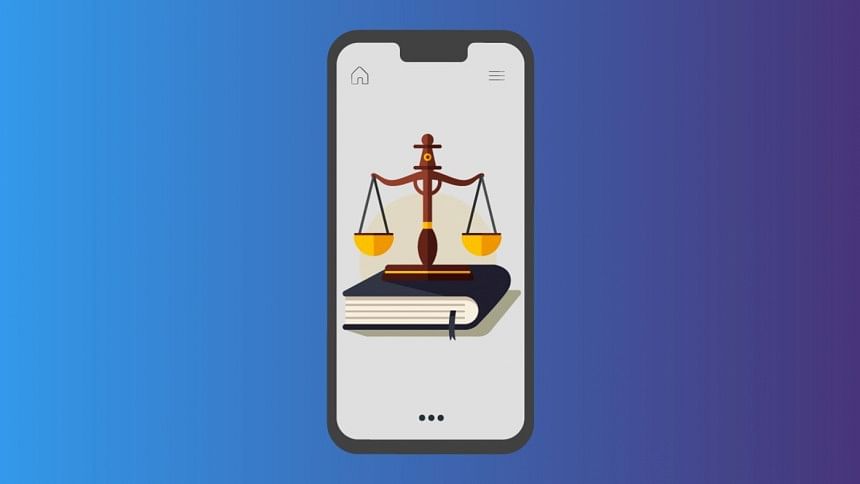Virtual courts and the future of justice

On May 9, 2020, the president of Bangladesh sanctioned the operation of virtual courts by the judiciary by passing the Adalot Kortrik Tothyo Projukti Byabohar Odhyadesh 2020 (roughly translated as the "Use of Information and Communications Technology in Court Ordinance 2020"). Typically, laws are passed by parliament and are called "acts" but Article 93(1) of our constitution allows the president to promulgate ordinances when parliament is not in session and "circumstances exist which render immediate action necessary", and it would have the "like force of law as an Act of Parliament".
The preamble to the ordinance states that the objective of the law is to empower the courts to make use of information technology to enable virtual attendance of parties to a case during trial and to allow the court to hold inquiries or hearings of applications and appeals and take evidence or deliver orders or judgments. "Virtual attendance" is defined as the presence or participation of a person in any judicial proceeding of a court through audio-video or any similar electronic medium. The ordinance is applicable to all courts of Bangladesh.
In finally opening the doors to virtual courts, Bangladesh has joined a list of countries across the world where the justice system has similarly responded to the coronavirus-induced lockdown with increased digitalisation. However, to think that the need for virtual courts only arose in the aftermath of lockdown would be to deny reality. It has been a long time coming. Coronavirus and the national lockdown aside, the formal justice system in our country is by and large painfully inaccessible to those who need it the most. Instead, courts are treated as a last resort by those whose rights have been violated, when all alternative means have failed. A survey by the Ministry of Law found that two of the biggest challenges justice-seekers face are the corruption of police when initiating cases and the long distance of district courts from their homes and the ensuing costs associated with travelling back and forth for seemingly endless court sessions (The Access to Justice in Bangladesh Situation Analysis, 2015).
Indeed, from my own research I have found that the physical distance to courts operates as a crippling factor for litigants even when conveyance is provided for court-related travel by legal aid providers, such as BLAST, who reimburse travel costs to all clients as a matter of policy. This is because transport cost is not the only factor making distance troublesome for litigants. Often times they are day labourers or otherwise employed in a job in which they must forego a day's wages every time they have to attend hearings in court. Additionally, female litigants from conservative families often require male relatives to accompany them to the main cities where the district courts tend to be located, and such relatives may not always be readily available as they too may need to forego their daily earnings. The same is true for aged litigants who may not be able to travel on their own. As a result, many clients simply lose interest in pursuing cases when they see endless court dates being scheduled with no signs of the case being settled in the near future.
Therefore, the virtual court system, in allowing people to attend hearings online and for judges to issue decisions therein, has immense potential in eliminating the distance factor and corruption issues. However, the extent to which the virtual court system can mitigate two of the biggest challenges hindering access to justice largely depends on how it is fleshed out in practice. The ordinance itself is quite vague and brief with only five generic sections. To this end, section 5 of the ordinance empowers both branches of the Supreme Court (Appellate Division and High Court Division) to issue Practice Rules (Special or Ordinary) in relation to the virtual court system. The day after the ordinance was passed, both branches of the Supreme Court duly issued 15-point "Practice Directions for Virtual Courts" on the Supreme Court website. Although issued separately, the Practice Directions of branches are largely identical in nature.
The first of these directions states that "Any lawyer wishing to file an application/petition is to file such application/petition via email address of the Bench Officer of the concerned Court along with an application requesting virtual hearing giving reason for urgency within 1 (one) page." The tenth direction states that upon receipt of the case application or petition by email by the Bench Officer, "the Judge shall, upon considering the urgency of the matter, fix a date and time of hearing and accordingly inform the Bench Officer concerned." From this, it becomes clear that individuals themselves are unable to file cases directly, rather it must be done through a lawyer. Additionally, not every case filed will necessarily be heard, rather the key determinant will be "urgency". It is not yet clear what the Supreme Court judges would consider urgent. On the other hand, the Supreme Court also issued Practice Directions for Subordinate Courts and Tribunals, which specifically state that they are to only hear matters relating to bail petitions. The decision to treat bail hearings as a matter of priority is justifiable given that an astonishing 81.3 percent of our total prison population comprises pre-trial detainees, i.e. those who have not yet been found guilty of committing any offence (World Prison Brief, 2019).
However, what about the victims of severe human rights violations whose evidence is especially time-sensitive, such as victims of rape and domestic violence (which has reportedly shot up in the lockdown)? It is vital that they too are able to seek recourse through the virtual court system.
Notably, in the past, there have been modest attempts to digitalise our judiciary in the context of violence against women by both parliament and the Supreme Court, but without much in the way of results. Section 20(6) of the Nari O Shishu Nirjatan Daman Ain 2000 (Amended 2003) commendably introduced in-camera trials for rape survivors. However, this is seldom, if ever, implemented, as it is not mandatory. Additionally, in Naripokkho and others vs. Bangladesh (2018), the High Court Division led by Justice Farah Mahbub (who also happens to be leading the committee established by the chief justice to reform High Court rules to facilitate virtual courts) issued a directive in 2018 requiring the government to launch a designated website "enabling the informant to register his/her complaint online". Sadly, this website is yet to see the light of day.
The introduction of virtual courts undoubtedly marks the onset of a historic era for our judiciary. Whether it can live up to its potential, and maximise access to justice for those who need it the most, very much depends on our recognising it as not only a temporary solution for the present but also the permanent solution for the future.
Taqbir Huda is a Research Specialist at Bangladesh Legal Aid and Services Trust (BLAST).
Email: [email protected]

 For all latest news, follow The Daily Star's Google News channel.
For all latest news, follow The Daily Star's Google News channel. 



Comments